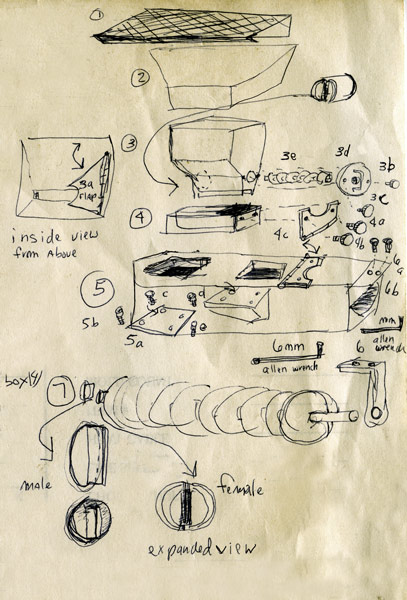|
|
|
|
|
Innards of A Chocolate Factory | *
*
*
*
*
* *
*
*
*
*
* *
*
*
*
*
*
To
choose the colour of your factory, hover over the asterisks... |
 Task I Task I
Cleaning
The Mixer
A. Get a parts cart or
flatbed.
B. Lift off the screen (1),
lay it back out of harm’s way.
C. Lift off bin (2),
lay back out of the way.
D. Scoop out contents into a good carton.
E. When the auger is uncovered,
vacuum the rest,
lifting the flap (3a) to get everything
F. Unscrew hand screws (3b and 3c)
G. Remove cover (3d) by its handle
H. Wipe it off.
I. Remove auger.
J. Lay everything on a cooler duct.
K. Unscrew hand screws (4a and 4b)
L. Swing down flap (4c)
M. Lift off small bin (3), separating it from the
box (4).
N. If small bin has chocolate on its bottom,
carry downstairs and put on the parts truck or
flatbed.
O. Remove box (4) and wipe clean if possible.
If not put on truck also.
SHUTTING DOWN THE SYSTEMS
FOR DUMMIES
(an easy to follow guide
for the rest of us)
These procedures can be used to meet any
of 4 goals:
#1. A shutdown due to malfunctions of
varying degrees.
#1 A. Emergency
#1 B. Non emergency
#2. A system that is ready to go for the
next run either hours or days in
the future. This is the usual, most
normal way of shutting down.
#3. A partially empty system ready for
an ingredient change.
#4. A entirely empty system ready for
maintenance work or a change of
product type.
******************************************************************************
┌───┐
│1 A │
└───┘
Shutting Down As Quickly as
Possible Upon Hearing a Piece of
Equipment
Make Self destruction Sounds, or
Smoke or Flame or Flood Appears.
Objective: You want to avoid damage to
equipment, or hazardous
conditions.
A. Push in the red emergency slap button
on the door of the large yellow
cabinets housing the PLC.
B. Select "System Stop" on the system
that needs to be shut down.
C. If a part of the process is going
haywire & nothing is actually on
the verge of exploding or otherwise
doing damage to the system it is
probably safe to simply shut off the MCC
breakers &/or the local
breakers for the problem area. The
situation can then be assessed &
you can decide if a system shutdown is
needed. If so, follow the
steps under #1 B.
*****************************************************************************
┌───┐
│1 B │ Shutting Down As Quickly As
Possible Due To:
└───┘
a. Maintenance needing to repair
something as soon as possible.
b. You have run out of space in all
Final Tanks.
c. You have run out of an ingredient
such as sugar, whey, oil,
etc.
d. Lack of time for some reason.
Objective: You only want to finish the
batches already begun & to
empty the 2 sets of scales.
A. Select "None" Fat Tank (if a batch of
fat is already beginning to
come in, wait until it is all in).
B. Hit "Shutdown Powder" (if it is
already bringing in the first
ingredient, wait until it starts
bringing in the second ingredient).
C. When the kneader is empty & the weigh
scale is empty, "System Stop"
may be hit.
D. If there is still a batch up in the
weigh scale you will have to turn
back on the fat tank that was being used
for one more batch. Go back
to "Cycle Parameters" & select the tank.
Wait for the fat to come
in, then go back & select "None" fat
tank again. On the other hand,
if maintenance is in an extreme hurry to
begin the repair, this step
may be
deleted and whoever starts up will need
to make a manual batch in
the kneader and also run the grinding
area manually until that dry
batch can be dropped.
E. If there is no rush you can wait
until the high level sensor is on at
the surge hopper, & the screw conveyor
to the mill shuts off, before
hitting "System Stop".
F. If there is plenty of time & you want
the system full, the high level
sensor of the pre mixer should be on. If
the last weigh scale batch
has dropped into the mixer & the high
level sensor is not on, another
weigh scale batch can be run. Don't
forget to hit "Shutdown Powder"
after the first ingredient is brought
in. If an ingredient has run
out, of course, this cannot be done.
*****************************************************************************
┌──┐
│2 │ Having The System Down & Full By A
Certain Time
└──┘
Objective: You want to run as many
batches as possible in the
available time, you want the 2 scales
empty & you want the surge
hopper & the pre mixer full. Again, this
is the most normal usual
way of shutting down.
A. Using the End of Run Summary
determine average batch time for the
past
couple hours on each system. Figure out
the # of your last weigh
scale batch so you'll know when to hit
"Shutdown Powder". Figure out
your last kneader batch so you'll know
when to select "None" Fat Tank.
1. End of Run Summary is found under the
"Recipe Download" pull down
menu.
2. Choose your System, go to the last
batch using the black arrow
boxes.
3. Looking at the "Date/Time" box on the
right, note the time. This
is the time that the kneader discharge
valve opened to begin
pumping out the finished batch & this is
when the system counts a
batch at the kneader.
4. Go back a few batches noting the
times each one finished & figure
out the time between: these are your
batch times(that is, the
length of a batch). Take the hours you
have to run yet & divide
by this average batch time to get the
number that can probably be
run.
5. To ensure that you are on track time
wise mark down your projected
batch times. This will also give you the
# of the last 4 batches
of cocoa. (for example: if you figure
out batch time is about 40
min. then if batch #34 begins pumping
out at 7:15pm + 40
min.batch time = batch #35 begins
pumping out at 7:55pm + 40 min.
= batch #36 begins pumping out at 8:35pm
+ 40 min.= #37 begins
pumping out at 9:15pm, etcetera.)
6. The system counts a batch at the
weigh scale when the slide gate
of the weigh scale closes after dropping
the batch into the pre
mixer. (System I pre mixer is called
Scott Mixer. The one on
System II is called BE 2000.
7. Normally it takes 2 weigh scale
batches to make one batch at the
kneader so it is safe to calculate
needing twice as many batches
at the weigh scale as at the kneader.
8. So if you know the last batch out of
the kneader will be, for
example, #32, that means you can
probably let the weigh scale
bring in 64 batches.
C. If the system is going to be down for
more than 8 hours the lower bin
of the cocoa bin should be drained.
1. Close the manual slide gate above it
& let the lower bin run
empty.
2. The bin holds about 436 lbs. which
could make about 4 weigh scale
batches but this will depend on the
recipe(s) being run.
3. Remember to close off the air supply
to the air sweeps before
opening the door of the lower bin.
4. Place a large white pan under the
door before opening. Use a
large scoop & a paddle to push the cocoa
down to the airlock. Do
not let the paddle get near the moving
airlock: turn off the
local breaker for the airlock if you
need to work near the
airlock.
5. Often the cocoa will not move through
the airlock fast enough &
you will need to scoop it out & dump it
into the air intake of the
BD pipe. (Remove the air filter cover &
the air filter first.
Use Caution! The blower will immediately
suck any objects smaller
than the pipe's opening into the pipe,
including & not limited to
the gloves off your hands. Use Caution!)
*****************************************************************************
┌──┐
│3 │ Having the system ready for an
ingredient change
└──┘
Objective: Last batches should be out of
the kneader & the weigh
scale, the Pre mixer will be empty, and
the surge hopper will be
empty or low.
System I only for dry ingredient change:
A. Determine the number of the last
kneader batch. Determine the
number of the last weigh scale batch.
Monitor a couple weigh scale
batches being dropped to see at what
point the high level sensor of
the surge hopper turns on. Make sure the
Pre Mixer is regularly
showing its high level sensor.
B. See above directions for emptying
lower cocoa bin. If you are
changing the ingredients in the bins
before your normal last weigh scale
batch if only the Pre mixer
needs to be empty; 8 if the surge hopper
must also be empty.
C. Hit "Shutdown Powder" 3 batches
before the normal last weigh scale
batch. The lower cocoa bin should have
been empty at that point.
|
|

| |
|
| | |
| | |
|
|
